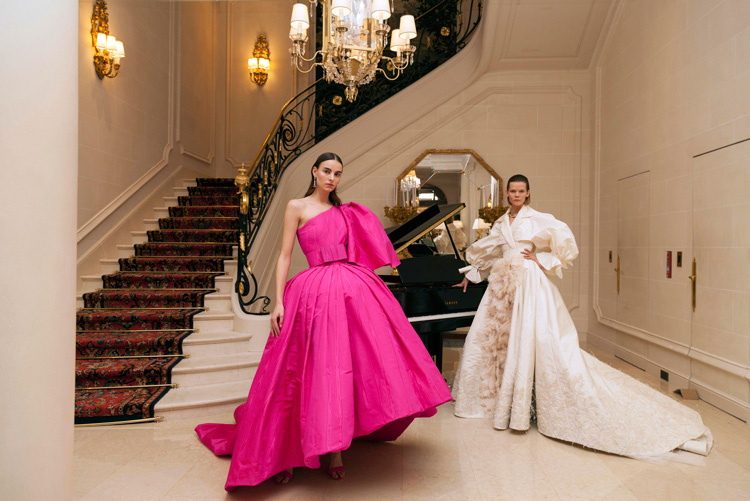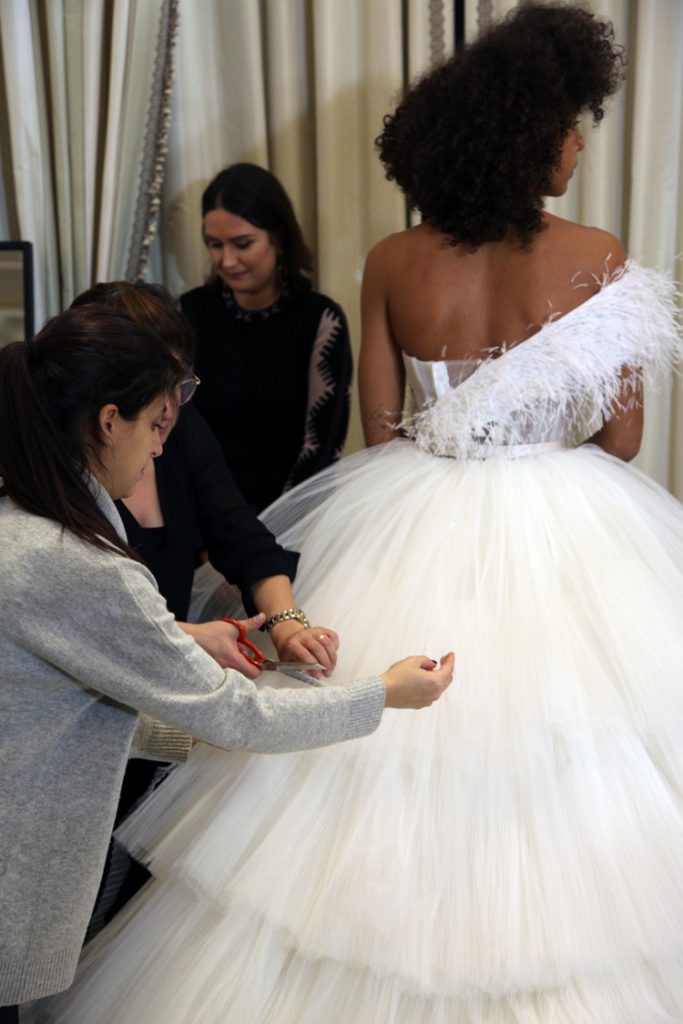A&E meets exclusively with Mohammed Ashi to discuss his recent show during Couture Week in Paris and the plans for the future of the Beirut-based brand.

Saudi-born Mohammed Ashi is making ripples in the world of Haute Couture. His Beirut-based brand, ASHI Studio, has become increasingly popular outside of the Arab world in the last couple of years, and he recently presented his first runway show at Couture Week in Paris, firmly making his mark on the international stage.
Ashi’s designs, through their sharp cut shapes and intricate details, present a classic update for the greatest codes of fashion. Mohammed Ashi has a refined taste for art and he embraces embroideries to capture the essence of luxury and tell fairy tales through every meticulously hand-crafted design.
The Spring 2019 Couture collection was entitled ‘Letters to Margaret’ and featured 27 pieces inspired by the 1950s and the 1990s. Show-stopping dresses were presented in luxurious fabrics such as lace, taffetas moiré and double satin, with delicate fabric manipulation, feathers, sequins, pleats, ruffles, and embroideries. The colour palette was bold, while there were also more understated pieces in black and white.
While his collections are flamboyant and bold, Ashi himself is quite reserved and tends to shy away from the spotlight. He rarely gives interviews but A&E was lucky enough to meet him at his studio in Beirut, fresh from presenting his Spring 2019 couture collection, where we sat down to discuss the brand and his vision.
We enjoyed a stunning collection for couture – what did you have in mind when you were designing it?
The whole thing came to me two months, before we realised what the collection would be. I saw a picture in a book for the same mood of an event from the 1950s and it caught my eye because of the details and the movement of everything.
Funnily enough, one of the guests that were invited was a muse of mine and this was a hidden message that I didn’t tell anyone about. This is how the collection got built. The direction changed a little bit when we started as I felt it wasn’t ‘ASHI’ enough. So I took a risk and took out the embroideries and put colour, which I never do, just to give that black and white image in my head a modern touch.
I added the fifties and then I added a nineties vibe too. There is a harmony and a fine line between both and I continued this through the whole collection. I was taking a risk, I wasn’t in my comfort zone at all. On the day of the fashion show, I didn’t have any feeling at all so I wanted to see what the feedback was from the people. I had a blank page in my book, I didn’t know what to expect. I tried to make it intimate.
I’m a very shy person and you saw the event was shy. I didn’t want it to be massive, I wanted to keep it very soft. 80 per cent of the people there I knew personally. I didn’t want to call it a fashion show I called it a dinner!

What do you think as a couturier is the biggest challenge?
I think it’s change. No one embraces change easily and with everything that’s happening with the economy, there are a lot of obstacles that will make you not want to change from a business perspective. I know other designers will not change, they will continue with what they are doing.
You have to decide if you want to be creative or you want to be a business tycoon – it’s a choice. I took a risk, it wasn’t as big as I wanted to take, but I think by next season the risk will be much bigger.
Creativity is something that is innate – if we go back to your childhood, how did you discover your passion and love for what you’re doing now?
It started when I was very young. When I was 10 or 12, my mother was the first one to open my eyes to what couture was. I am the only boy with four sisters so I’m surrounded by girls with dresses the whole time and my mother was always very keen on dressing herself and changing her image. So this opened my eyes.
I looked up to my mother. My father figure was there, but the mother figure was stronger – I have a very strong mother! So it started from there. She used to drag me with her everywhere and I remember we went to visit a couple of designers. It was the experience of seeing the fabrics that inspired me.

I left Saudi Arabia when I was 15 and moved to the States to study marketing. At this point, I was still attached – not to fashion but to art. All the classes that I could choose were art. At one point I almost changed my major but I didn’t, I continued with what I was doing. At some point, I changed from art to fashion. I felt there was something with fashion that I was drawn to – I watched a lot of fashion shows, I saw a lot of images.
I have a solid base when it comes to fashion but I polished it. When I look at something I have a very strong visual memory, so I can remember a jacket for example, for ten years after I’ve seen it once. Sometimes when I sit down I have images in my mind. I can’t design without listening to classical music, so I’ll put that on and the images will come to me and the pen starts walking by itself.
What do you still aim to achieve that you haven’t done yet?
If you don’t dream big, you’re not dreaming at all. If you put a limit on yourself it limits you, I just want to feel the moment. I have to be attached to this moment to make me go to the next phase. It’s not about a fashion show or an achievement it’s about the moment.
What is the motto you live by?
I don’t have limits or boundaries I have to have freedom – I drive with no restrictions.
If you were to give your younger self one piece of advice what would it be?
It’s actually the opposite. The younger me is advising me right now! He gave me all those dreams and now he’s advising the current me.
Do you have any regrets?
No, I don’t regret anything. Everything I did made me who I am today so I can’t regret anything. It is always a constant fight and struggle deep inside.
What was a challenge that you had and how did you overcome it?
I used to get affected by challenges. I would surrender to the moment. But my struggles today taught me to be brave and know that everything will change and be better soon.
What book are you reading?
I have so many books in front of me! I read a lot of poems. I read a lot of Virginia Wolf. I also read novels and watch a lot of movies. I read the end first, I’m one of those people that is very eager to know whether it’s worth going through all the drama!
What do you say no to?
I say no to no! You tell me no I tell you yes!

What inspires you when you’re in your zone?
Places inspire me a lot. When I travel, I travel though time. I feel that I’m attached to anything that is old. I believe in past lives and I think this is something that you take from your past life. I’m fascinated with gardens, old houses, old paintings – I think I’m an old soul and I’m taking that soul with me everywhere I go.
They say creativity comes out when you are emotional – when are you at your most creative?
You don’t create art from happiness you create it from sadness. This is why I usually call my work ‘Dark Romance’. Dark not as in grunge but as in sad. Everyone around me knows that I support women and this can often be women who aren’t in their best shape emotionally. For example, if you go back to some of my old collections – ‘Exiled Queen’ for example – there is always a pain in the female in what I do.
If there was one thing you would like to change in yourself what would it be?
I’m impatient! I would like to be more patient but I don’t think that will change!
In one sentence what should we be expecting from your coming collection?
A new vision of ASHI. It’s something completely different and I’m pushing the boundaries to a whole new level.

Will you remain out of your comfort zone?
Yes I will. I think it’s steps. I will try to change and give something new.
Who is the woman you design for?
All my muses have suffered or something happened that changed them. They all had big turning points in their lives.
Is there a woman you would like to see wearing your designs?
Wallis Simpson – 100 per cent.
How would you like to be remembered?
Should they remember me?! Through my work I would like to leave a message. It’s not about the dresses or work but it’s a message that I want people to understand and I think that will come with more exposure. It’s not something tangible, it’s a feeling. When you give someone a feeling it’s much more important than a physical thing.















